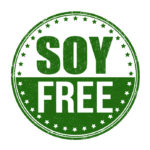- Early signs of soy allergy are rash, hives or eczema.
- Avoid (do NOT eat, drink, or consume) soy, have an emergency plan, and always carry an epinephine autoinjector such as Epipen®.
- Research shows that most children will outgrow their soy allergy by the age of 10.

A soy allergy is an allergy to soybeans and is a common food allergy affecting 0.4% of children. Soy allergies are often detected during early infancy as many infant formulas are soy based. Research studies have found that most children with a soy allergy will outgrow the allergy by the age of 10. A soy allergy develops when the immune system identifies certain soy proteins as harmful, causing an allergic reaction.
How do I know if a food has soy in it?
All packaged food products sold in the US that contain soy as an ingredient must list the word “soy” on the label so be sure to read all product labels carefully before buying and consuming any item. Additionally, be sure to avoid foods with any of the following ingredients:
- Cold pressed, expelled, or extruded soy oil (see note below)
- Edamame
- Miso
- Natto
- Shoyu
- Soya
- Soybean
- Soy protein (including soy protein isolate, soy protein concentrate, and hydrolyzed soy protein)
- Soy sauce
- Tamari
- Tempeh
- Teriyaki sauce and other sauces that might be made with soy sauce
- Textured vegetable protein (TVP)
- Tofu
- Yuba (bean curd)
There are some unexpected sources of soy as soybeans and soy products can be found in many foods including:
- Baked goods
- Canned tuna and meat
- Cereals
- Chocolate
- Cookies
- Crackers
- High-protein energy bars
- Infant formulas
- Low-fat peanut butter
- Processed meats
- Sauces
- Canned broths and soup
- Vegetable gum, broth, and starch
If I have an allergy to soy, are there any other foods I need to be careful about?
Under FDA (Food and Drug Administration) guidelines, highly refined soybean oil does not need to be labeled as an allergen. Research has shown that most people can safely eat soy oil if it has been highly refined because the protein has been removed. Soy lecithin does contain a small amount of soy protein and must be labeled on the product. However, the amount of protein is so low that the majority of people allergic to soy will not have a reaction to soy lecithin. If you have an allergy to soy, please talk to your health care provider to find out whether or not you should avoid soy oil and/or soy lecithin.
Asian cuisines are identified as high-risk for people with a soy allergy. Soy is a commonly used ingredient in Asian dishes and there is a high risk of cross-contamination even if the item listed on the menu does not appear to contain soy.
Are there any non-food products that might contain soy?
Yes! It might sound surprising but soybean products are being used in many non-food products and even used to power city buses, insulate buildings, and even used in the filling of some stuffed animals. Many companies are marketing their products as “green” and “eco-friendly” which often means that a soy-based alternative to petroleum products is being used. The research is still unclear on soy food allergies and non-food soy products so it is always import to check the ingredients of cosmetics, shampoos, or anything else you might be putting on your skin. And of course, if you have soy allergies don’t put these products in your mouth.
If you do have soy allergies, be sure to carefully read labels of the following products to check for any soy ingredients:
- Candles
- Cosmetics
- Hand sanitizer
- Lotion
- Shampoo & conditioner
- Soap
 Young Men's Health
Young Men's Health

